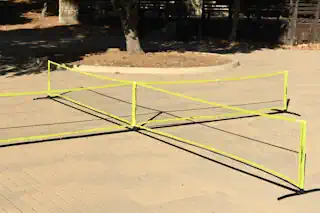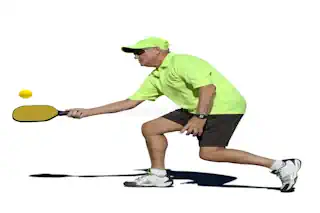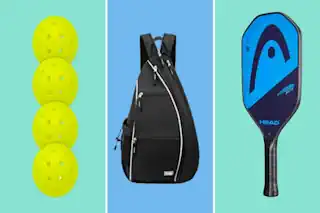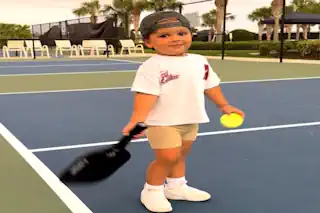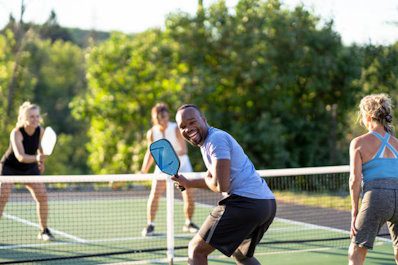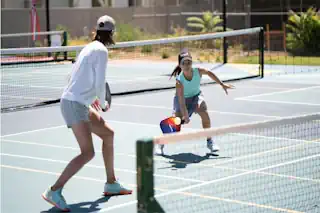Expanding Your Pickleball Horizons with Double Dutch

Pickleball, with its whimsical name and its surprising mix of badminton, tennis, and table tennis, has been winning the hearts of players all over. Have you played yet? Do you desire to play better? Here we are creating game play variations to be used as training tools to help with a variety of aspects of this wonderful game.
Enter: Double Dutch Pickleball – a thrill-inducing variant with a training edge over the standard game. As a Pickleball enthusiast, you’re in for a treat with this quick guide to igniting your passion for Double Dutch.
Let’s Start with the Basic Rules of Pickleball
The Rules Reminder
Before we get into the swing of things, it’s important to know the fundamental rules of pickleball play. Players use solid paddles made of wood or composite materials to hit a perforated polymer ball, similar to a Wiffle Ball, over a net. The net is lower than in tennis but not as low as in badminton. The game can be played either with two players (singles) or four players (doubles).
Here’s a quick rundown of the basic pickleball rules to get you started. Think of it as your quick-start guide to fun:
Serve it right: Serve must be underhand with the paddle below the waist, and the ball must be hit in the air without bouncing. The serve is made diagonally across the court to the opponent’s service zone.
Service errors: Errors during service, such as serving out of turn, serving the ball into the net, or serving the ball out of bounds, lead to faults. Keeping a keen eye on your serve’s direction and height can help avoid these mistakes.
Double-bounce rule: After the ball is served, the receiving team must let it bounce once before returning, and then the serving team must also let the returned ball bounce once before playing it. After these two bounces, players may either volley the ball in the air or play it off a bounce.
No-volley zone: The court has a 7-foot zone on either side of the net, known as the “kitchen,” where players cannot volley the ball. Players must observe this rule to avoid faults.
Scoring: Points can only be scored by the serving team when the opponent fails to return the ball or commits a fault. The game is played to 11 points, and a team must win by at least 2 points.
Switching sides: Each team switches sides after the first game. In a tiebreaker (the third game of a match), teams switch sides when one team reaches 6 points.
Stepping into the kitchen on a volley: One of the most common faults in pickleball occurs when a player steps into the no-volley zone, or the kitchen, to hit a volley shot. Remember, you can step into the kitchen to hit the ball if it bounces first, but volleying from within this zone is a definite no-go.
Hitting the ball out of bounds: Just like in tennis or badminton, if the ball lands outside the designated play area, it’s considered out, and the point goes to the other team. Judging the ball’s trajectory and controlling your shot power are key skills to keep the ball in play.
Remember, pickleball is as much about having fun and making friends as it is about following these rules. Grab your paddle, and let’s hit the court with smiles and sportsmanship!
Equipment Essentials
The gear for Double Dutch Pickleball isn’t much different from the standard variant. You’ll still need a net, a court, paddles, and pickleballs. The only ‘extra’ here is perhaps a tad bit more stamina and coordination.
The Purpose of Double Dutch
The primary purpose of Double Dutch is two fold. First it is to help each player with court awareness. For newer players, letting a ball land out of bounds or stepping into the kitchen takes time to learn.
The second purpose is to help team players during doubles play learn to communicate without a need for speaking intention. If one player advances or retreats, unless previously planned, the team mate should follow.
Double Dutch – Here Is How It is Done
We start with a standard serve. Ball hit below the waist and cross court.
Next is the double bounce rule. The receiving team must let the ball bounce before hitting it back and the serving team must let the ball bounce before hitting it back
Now we start Double Dutch
The serving team, immediately after hitting the return from the receiving team, must advance to the kitchen line. The receiving team must stay at the back court line.
The receiving team returns the ball and must immediately advance to the kitchen line. The serving team hits the ball at the kitchen line but then must immediately back up to the back court line.
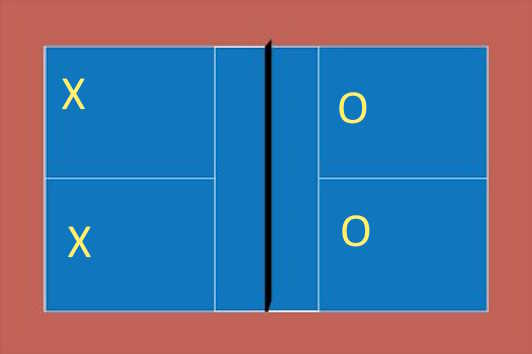
The intent is for one team to be advancing to the kitchen line at the same time the other team is retreating to the back court line. As play continues the teams keep advancing and retreating. If the advancing team can hit a dink into the kitchen while the other team is retreating they win the round. Similarly, if the team at the kitchen that is about to retreat can hit a lob shot over the advancing team, who must move to the kitchen line, they win the round. As the volleys continue the game gets faster and faster.
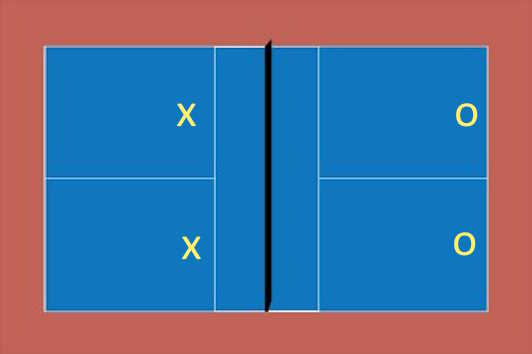
Dinking and Dropping
Mastering the ‘dink’ and the ‘drop’ can be game-changers in Double Dutch. These soft, low shots are difficult to successfully execute when running towards the kitchen line. Hence, one of the goals is to help you learn to effectively execute these soft shots while advancing. The more strategic goal is to help you learn to recognize those times when your opponent is retreating and can be caught off guard with a well placed dink shot.
The Lob Shot
In Double Dutch, you will need to execute a lob shot when you are retreating. It is the best way to place the ball where your opponent cannot return the shot. If your lob shot is short, the other team can execute a drop shot and the round is over. If you are successful, the other guys will run under your lob and look back to see it successfully land in the back of the court. The lob shot must be a slow speed strike with lots of control. Learning to hit a successful lob shot from the kitchen is part of this drill. The strategic goal is to learn to recognize when you opponent is advancing and surprise them with a lob shot well placed in a back corner.
Beyond the Court – The Social Angle
Pickleball communities are known for their friendly and inclusive nature. Double Dutch Pickleball takes this camaraderie to new heights, encouraging even tighter knit teams and truly championing the social aspect of the sport.
Partnership and Friendship
The bond between partners in such a big part of Double Dutch Pickleball. You learn each other’s moves, predict the bounces, the volleys, and, most importantly, celebrate each other’s successes.
The Community Playbook
Community leagues and tournaments are fantastic ways to immerse yourself in the world of Pickleball. Double Dutch will help you and your partner be more comfortable during competitive play so you can focus more on creating a network of support and friendship.
The Future – Riding the Double Dutch Wave
The Double Dutch drill is new in the pickleball world. With its increased emphasis on agility and coordination, the variant is expected to enhance team players communication and strategic play. The Double Dutch drill is more than just a playful twist on a popular pastime. It’s an effort to learn touch, ball placement and teamwork. Hitting he ball harder with lots of speed will not help you hit volleys that will win this game. Your pace, control, speed and agility will all possibly be pushed a bit during this drill.
Ready to take the plunge into the world of Double Dutch? I hope you are. Grab a partner, a paddle, and hit the court. The game awaits, and the spin’s delightful!
Frequently Asked Questions (FAQs)
Q: Do I need any special equipment for Double Dutch Pickleball?
A: No, the equipment for Double Dutch Pickleball is the same as standard pickleball. You will need a net, a pickleball court, paddles, and pickleballs. The only additional requirement might be more stamina and coordination due to the nature of Double Dutch play.
Q: Can beginners participate in Double Dutch Pickleball?
A: Absolutely! Double Dutch is designed to improve court awareness, control, footwork and non-verbal communication between team players, making it an excellent variant for beginners to learn and seasoned players to refine their skills.
Q: How does the scoring work in Double Dutch Pickleball?
A: The scoring system in Double Dutch follows the standard pickleball rules. However, winning a round through strategic shots like dinks into the kitchen while the opponent is retreating, or successful lob shots over an advancing team, adds a layer of strategy and fun to the scoring.
Q: Is Double Dutch Pickleball recognized in tournaments?
A: While Double Dutch is a newer drill and may not yet be widely recognized in official tournaments, it’s gaining popularity. Participation in community leagues and practice sessions can help promote its inclusion in competitive play.
Q: How can I find a partner to play Double Dutch Pickleball?
A: Look within your local pickleball community or club. Many players are eager to try new variants, and it’s a great way to strengthen partnerships and friendships. Community playbooks and social events are also excellent opportunities to find like-minded players.
Q: What is the best strategy for winning in Double Dutch?
A: Coordination and communication with your partner are crucial. Mastering the dink and lob shots, especially timing them when your opponent is in a vulnerable position, can significantly increase your chances of winning. Developing these strategies with practice will make you and your partner formidable opponents on the court.
